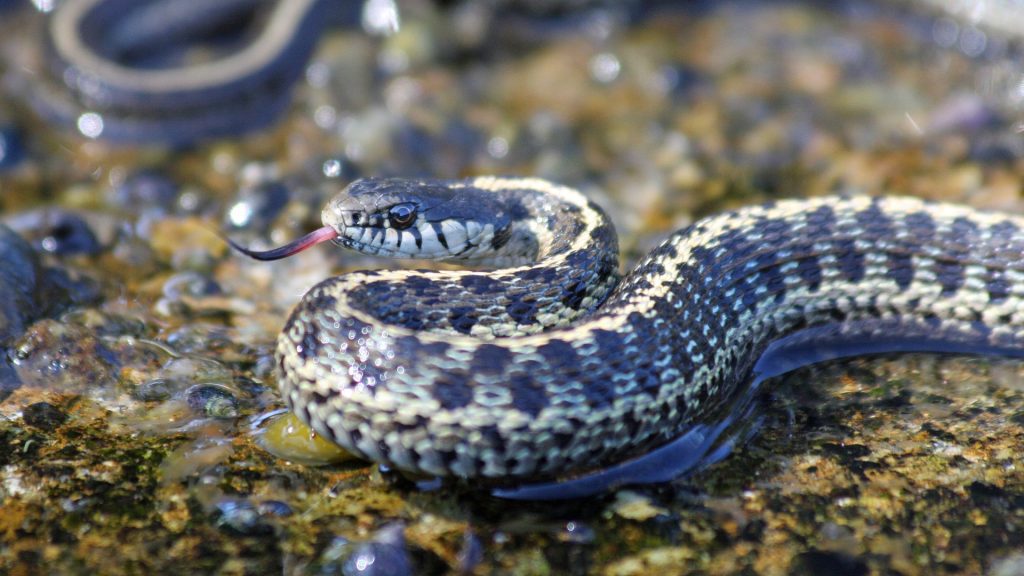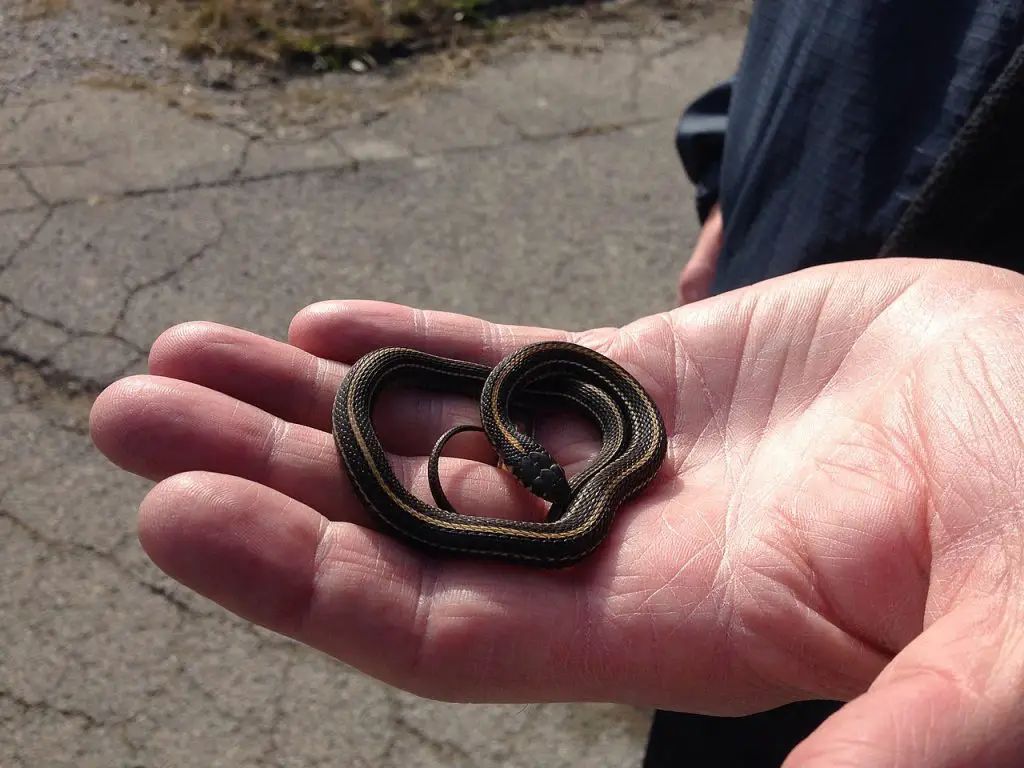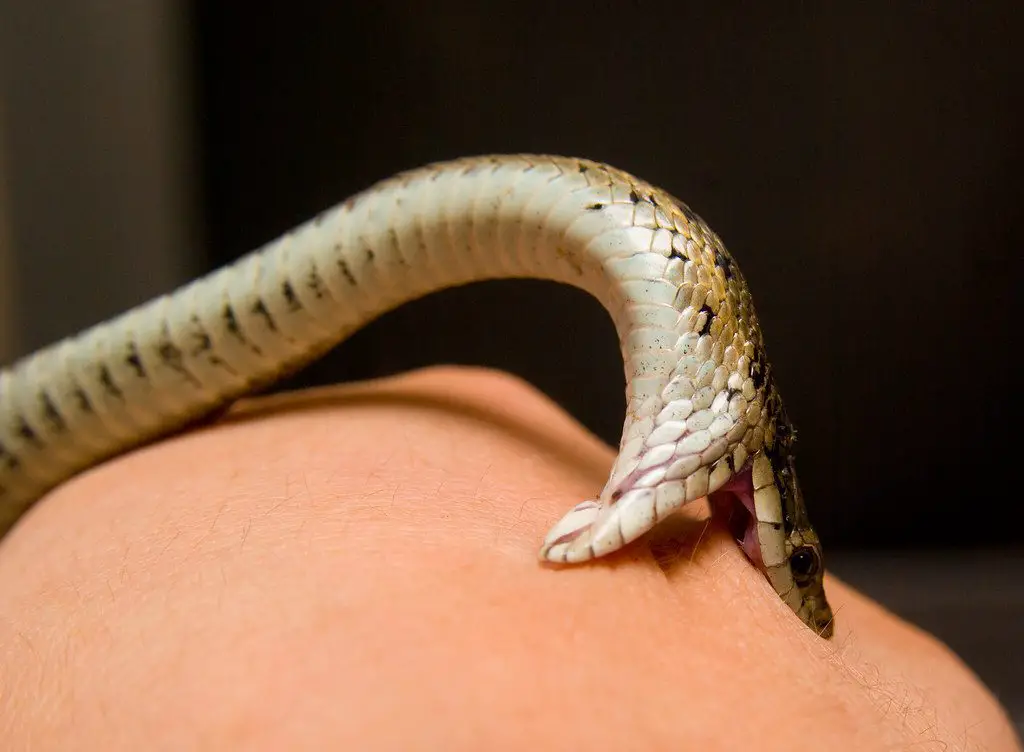Do Garter Snakes make great pets? That is a question that many people are asking themselves these days. Garter snakes are becoming more and more popular as pets, and for good reason! They are docile, easy to care for, and relatively inexpensive.
In this blog post, we will discuss the benefits of owning a Garter Snake, as well as some of the things you need to consider before bringing one into your home.
Key Takeaway
- Garter snakes can make great pets as they are relatively easy to care for, adapt well to handling, do not require a lot of space, and have a manageable size, usually growing about 3-4 feet long.
- Garter snakes are not considered high-maintenance pets as they adapt well to various environments, do not require a lot of space, and are easy to feed and care for, although they do require regular habitat cleaning and a secure vivarium to prevent escape.
- Garter snakes do hibernate, often from late October through March or early April, and they stay hydrated by absorbing moisture through their skin during this period.
Do Garter Snakes Make Great Pets?

Yes. Garter snakes can be great pets for the right person. They are easy to care for and don’t require a lot of space. Garter snakes also make interesting pets because they are so different from most other types of animals. If you’re interested in getting a pet snake, a garter snake may be the perfect choice for you!
When considering whether or not a garter snake is a right pet for you, it’s important to think about your lifestyle and what you’re looking for in a pet. Garter snakes can be active or passive depending on their environment.
So, if you’re looking for an active pet that will keep you on your toes, this may not be the best choice. On the other hand, if you’re looking for a more low-maintenance pet that you can enjoy watching and handling, a garter snake may be perfect for you.
If you think a garter snake might be the right pet for you, do some research to learn more about their care and needs. Once you’ve decided that you’re ready to take on the responsibility of owning a reptile, visit your local pet store or reptile rescue to find your new best friend!
Are Garter Snakes High-Maintenance?

No, garter snakes are not high-maintenance. They make great pets for people who have busy lifestyles because they don’t require a lot of care. Garter snakes can be kept in a simple terrarium with a water dish and some plants, and they only need to be fed every two or three weeks.
Garter snakes also adapt well to different environments, so you can keep them both indoors and outdoors. If you live in an area that has cold winters, you can keep your garter snake inside during the winter months and let it outside when the weather is warm. Garter snakes are hardy creatures and can survive in a wide range of habitats.
Garter Snake’s diet consists of slugs, worms, small fish, and frogs. However, they do need to eat more frequently than other snakes, making this challenging for any owner who is not present during the day.
They don’t eat mice. I’m particularly squirmish about feeding mice to snakes because I like mice as pets.
Their housing is simple enough and can either be made of a storage box, a tank, or an aquarium. 10 square footage of living space is all your Garter snake will ever need.
If you want to keep things simple, you can buy a reptile tank as these usually come fitted with all the accessories that your garter snake will need.
But if you are low on budget, a box will do as long as you escape-proof it and provide substrates such as soil, moss, or newspaper.
You should also provide accessories such as rocks to hide under, logs to climb into or onto, and foliage to mimick the underbrush in the wild.
Garter snakes also need suitable lighting and temperature conditions to be healthy. Always maintain their temperature at 70 degrees but also provide a warmer basking area. Their lighting should be gentle, not bright, direct lighting.
Garter snakes bear their children instead of hatching. This means that if you want to start breeding them, you can do so without worrying about incubating eggs.
These reptile pets can cohabitate with other garter snakes, although it is advisable to keep them in separate cages.
Do Garter Snakes Hibernate?
Yes. In the winter, garter snakes will often congregate in large groups to hibernate. This is because they are cold-blooded and rely on the sun to warm their bodies. When it gets too cold, they will go into a deep sleep called brumation. During this time, their metabolism slows way down and they will not eat.
Garter snakes usually hibernate from October to March.
In the winter months, when temperatures drop and food becomes scarce, garter snakes will enter into a state of brumation. Brumation is similar to hibernation in mammals, but it is not as extreme. Garter snakes do not fully shut down their metabolism or body functions as mammals do.
Instead, they enter into a state of dormancy where they slow down their heart rate and breathing and lower their body temperature. This allows them to conserve energy until the weather warms up and food becomes more plentiful.
If you have a pet garter snake, you will need to provide a warm place for it to sleep during the winter months. You can use a heating pad set on low, or an under-tank heater, to create a warm spot for your snake.
Be sure to provide plenty of hiding places as well, so your snake can retreat if it gets too warm. Garter snakes typically hibernate from October to March, but this can vary depending on the temperature and food availability in their environment. If you live in an area with a mild climate, your snake may not enter into brumation at all.
Garter snakes don’t eat or drink while hibernating. Their skin absorbs moisture from their environment to keep them hydrated, while for their nutrition needs, they depend on stored body fat.
Do Garter Snakes Bite?

Yes. Garter snakes can and do bite. Garter snakes are non-venomous and not considered dangerous to humans, but they can give a painful bite if handled roughly. In fact, the vast majority of garter snake bites are harmless. That being said, there is always a chance that a snakebite could cause an infection or some other complication, so it’s best to avoid being bitten by any snake if possible.
If a Garter snake bites you, sterilize the area by washing thoroughly to prevent the build-up of harmful bacteria. You should also go to the hospital if your tetanus shot is not up to date.
You may experience adverse reactions to the bite, such as itching and swelling. If symptoms get worse, or if you experience a strong reaction, see a doctor.
Note that the snake may leave you smelling foul from its musky secretions. This side effect is unpleasant but harmless and should dissipate once you wash it off with soap and water.
Are Garter Snakes Harmful to Cats and Dogs?
One common question pet owners have is whether or not garter snakes are harmful to cats and dogs. The answer, thankfully, is no. Garter snakes will generally avoid contact with larger animals and instead prey on smaller creatures like rodents or frogs. However, their bite is considered mildly venomous and could hurt your furry pet.
In fact, garter snakes can actually be beneficial to a household by helping to control the population of rodents and other pests. So if you’re ever lucky enough to spot a garter snake in your yard or garden, don’t worry – your pets are safe!
On the other hand, a dog or a cat might attack and injure the Garter snake. Only then will the Garter snake see them as threat and bite them.
If you notice your dog or cat has been bitten by a Garter snake, it is important to seek professional medical help immediately and bring them to the vet.
If you are unable to get to a vet right away, there are some things you can do to help ease your pet’s pain and discomfort:
- First, keep your pet calm and quiet. Do not allow them to run or play as this will increase their heart rate and spread the venom more quickly through their system. Apply a cold compress or ice pack wrapped in a towel to the bite area for 20 minutes at a time. This will help reduce swelling.
- Give your pet plenty of fluids, either water or an electrolyte solution like Pedialyte, to prevent dehydration. If your pet is vomiting or having diarrhea, you may need to give them an anti-diarrheal medication as well. You can also give them a pain reliever like ibuprofen if they are in pain.
- Monitor your pet’s vital signs, such as breathing rate and heart rate, and keep track of how they are responding to the treatment. If their condition worsens, seek emergency veterinary care right away.
Are Garter Snakes Good To Have in Your Yard?
Yes. Garter snakes are good to have in your garden. Garter snakes can be helpful to have around. But, it is important to keep an eye on them and make sure they are not becoming a nuisance. They will help you get your pest problem under control if your garden has bugs and rodents. They eat grasshoppers, slugs, rats, and leeches.
However, it’s probably best not to have them there for long as they will also eat bugs that are beneficial to the health of your garden. Other precautions to follow when you decide to have your garter snake out in the garden include:
- Only let your snake into an enclosed garden and supervise its time there so that it doesn’t wander off.
- It’s better to have some garden time when there is no one at home so that your snake doesn’t feel threatened from all the excitement that comes with having people over. Some people are also frightened of snakes and may therefore react in a way that frightens the garter snake, causing it to bite.
Are Garter Snakes Social?
Yes. Garter snakes are social animals. While most snakes prefer to stay alone, garter snakes thrive on the company of other snakes. One of the things that makes garter snakes so social is their mating behavior.
Male garter snakes will often form “mating balls” with several other males. The females will then choose a mate from the ball. This allows the females to pick the best mate possible and helps ensure that the genes of the strongest males are passed on to future generations.
According to researchers, garter snakes like the companionship of other members of their species, and even appear to form friendly relationships with them.
Garter snakes are also very social creatures and often live in groups.
Another reason why garter snakes are social is that they rely on each other for protection. If a predator finds one snake, it’s likely that other snakes in the group will warn each other and help defend their pack. This can be very beneficial, especially when there are many snakes together.
These social relationships aren’t just for the company. They play an important role in survival as well:
- A single garter snake may find it hard to stay warm but a group of snakes can retain moisture and heat better.
- If a predator attacks one garter snake, chances of getting away aren’t as good as if an entire group of them were to collaborate in fighting off a predator.
- Even more interesting is that garter snakes rely on each other for information. Members of a group know it’s safe to go out if they see one of their own explore without being preyed upon.
Do Garter Snakes Smell?
Garter snakes have a unique smell that is often described as being musty or earthy and are considered smellier than most snakes. While this smell may not be pleasant to everyone, it is what helps Garter snakes identify other members of their species and track down prey. The scent glands located near the snake’s head produce a distinctive odor.
Interestingly, some people find the smell of Garter snakes to be quite appealing, likening it to certain herbs or spices.
As their diet is so varied, you can get a range of smells from their feces depending on what they’ve eaten that day. They pass watery feces when they eat worms, although it’s not as stinky as when they eat fish. Their feces also has a distinctive smell when they eat mice, although the odor is not so different from the feces of other species of snakes when they’ve eaten mice.
The good news is that rattlesnake feces are smelliest just after defecation, but the smell tends to subside as it dries. The bad news though is that they defecate so often, so you may have to deal with that smell several times a day.
That said, the smell of feces is usually concentrated around the cage and its immediate surroundings. It wouldn’t stink up the entire room or house. You can control the smell by cleaning out the feces every time you notice a bad odor. However, this will give you a lot of work.
Another thing you can do is vary their diet. For instance, if fish seems to result in very smelly poop, only give it every few days.
Are Garter Snakes Constrictors?
No, garter snakes are not constrictors. They kill prey by biting them and injecting venom. Garter snakes can also eat prey that is much larger than their head by unhinging their jaws. This allows the snake to swallow its prey whole.
Constrictors wrap their bodies around prey until they suffocate it. Garter snakes are harmless to humans and pose no threat. However, if you are bitten by a garter snake, seek medical attention immediately as they can be carriers of rattlesnake venom.
Garter snakes are known to be aggressive predators. When they attack their prey, they first wrap themselves around the victim tightly. Then, they constrict their coils until the victim suffocates or dies from blood loss. Finally, the snake will consume the victim whole. This entire process can take up to an hour.
These snakes are found in various parts of Africa and Asia. In Africa, they are particularly common in countries like Kenya, Ethiopia, and Somalia. In Asia, you can find them in countries like India and Pakistan.
Garter snakes typically hunt during the night. They use their sense of smell to track down their prey. Once they have located their target, they will strike quickly and without warning.
Despite their aggressive nature, Garter snakes are also known to be quite timid. If they feel threatened, they will often flee rather than fight. This makes them relatively easy to catch if you know what you’re doing.
FAQs
Q: What are the benefits of having a garter snake as a pet?
A: Garter snakes are small in size and do not require a large enclosure. They are also relatively inexpensive to feed as they mainly eat insects, worms, and small fish.
Q: Are garter snakes venomous?
A: Garter snakes do possess a mild venom, but it is not harmful to humans. Their bites may cause slight irritation or swelling, but they are generally considered harmless.
Q: What is the average lifespan of a garter snake?
A: Garter snakes have an average lifespan of around 5 to 10 years in captivity, although some have been known to live longer with proper care.
Q: What kind of enclosure do garter snakes need?
A: Garter snakes require a secure enclosure with proper ventilation. A glass terrarium or a properly designed snake enclosure with a secure lid is recommended.
Q: What do garter snakes eat?
A: Garter snakes are carnivorous and primarily eat insects, worms, small fish, and frogs. They should be fed a diet of appropriately sized prey items.
Q: How often should I feed my garter snake?
A: Garter snakes should be fed every 5 to 7 days. The portion size should be appropriate for their size, and any uneaten food should be promptly removed from the enclosure.
Q: Do garter snakes require any special heating or lighting?
A: Garter snakes are ectothermic, meaning they rely on external sources of heat to maintain their body temperature. They require a thermal gradient within their enclosure, with a warm side and a cooler side. A heating pad or heat lamp can be used to provide the necessary warmth.
Q: How often do garter snakes shed their skin?
A: Garter snakes shed their skin approximately every 4 to 6 weeks, depending on their growth rate. It is normal for them to become dull and their eyes to appear cloudy before shedding.
Q: Can I handle my garter snake?
A: Garter snakes can tolerate handling, but they are generally not as comfortable being handled as other pet snakes. If you do choose to handle your garter snake, make sure to wash your hands before and after to avoid transmitting any potential bacteria or parasites.
Conclusion and final thoughts
In conclusion, garter snakes make great pets for those looking to adopt a non-traditional pet.
They require minimal commitment and don’t take up much space or need expensive habitats.
Garter snakes are also relatively easy to care for, needing only a warm environment with access to fresh water and food sources.

